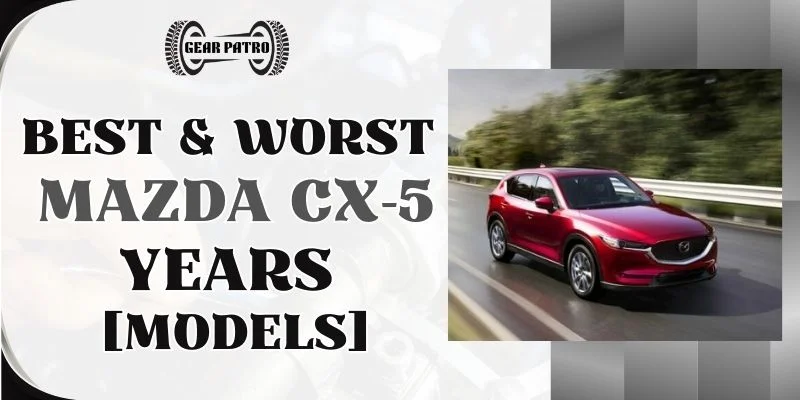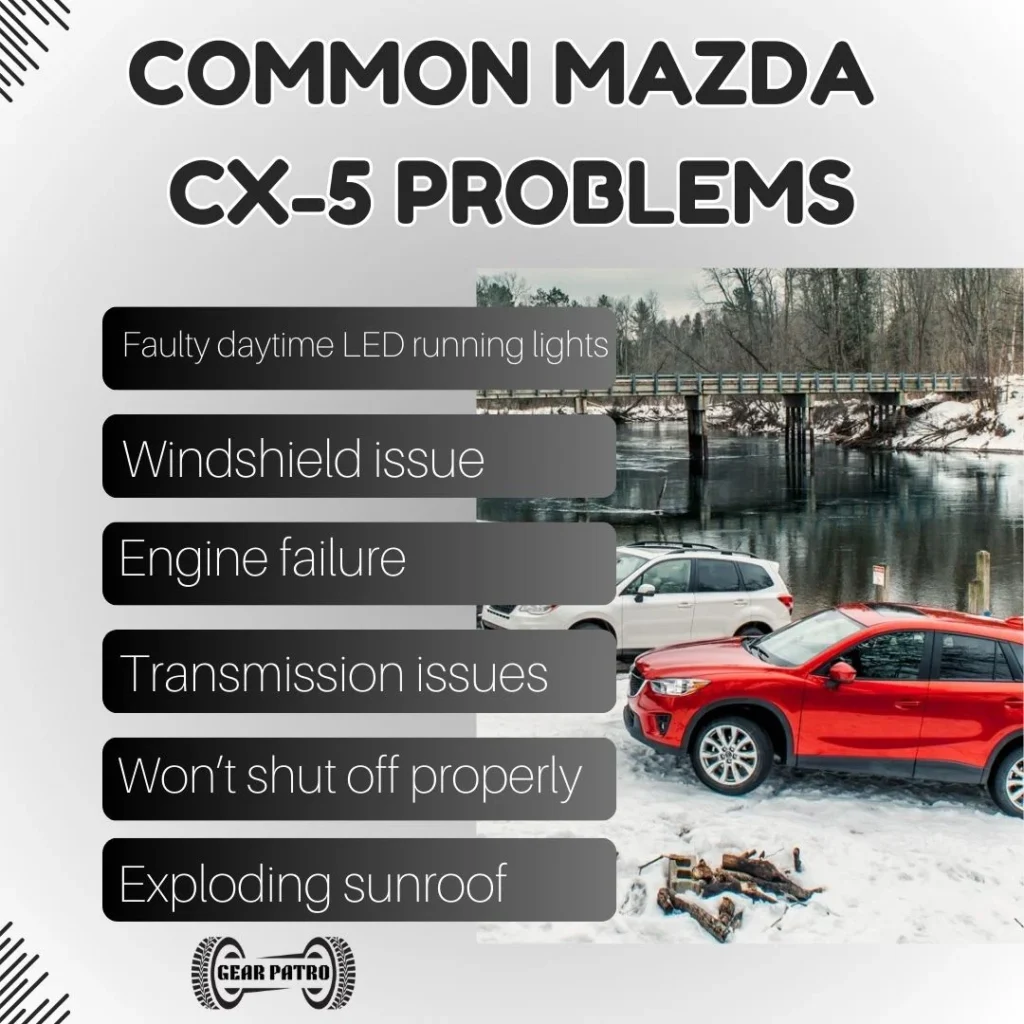Mazda CX-5 models from its worst years could cost you a lot of money. In light of this analysis, the following Mazda CX-5 years should be avoided.
With this guide, you can determine the best Mazda CX-5 generation to buy, as well as the worst Mazda CX-5 generation to avoid.

Here is a data-driven analysis of the Mazda CX-5’s lifespan, using insights from the National Highway Traffic Safety Administration, J.D. Power, and direct owner feedback.
In this article, we will compare the Mazda CX-5 years with the best powertrain options, safety features, reliability issues, and recall histories.
We’re ready to begin.
Mazda CX-5 Generations
With its first generation in 2013, the Mazda CX-5 launched an era with KODO: Soul of Motion design philosophy and SKYACTIV technologies.
This compact crossover combines a fun driving experience with a versatile design and excellent fuel economy.
This table covers every Mazda CX-5 generation, from 2013 to present.
| Generation | Years |
| 2nd generation (KF) | 2017-Present |
| 1st generation (KE) | 2013-2016 |
Mazda CX-5’s evolution is crucial to understanding whether you’re a prospective buyer or an enthusiast. The hallmarks of each new generation are technological advancements, improvements in performance, safety, and comfort.
Mazda CX-5 Best, Neutral, and Worst Years
The following factors are taken into account when ranking and categorizing the Mazda CX-5’s best and worst years:
The compiled data has allowed us to create a concise table that ranks Mazda CX-5 model years according to their best, neutral, and worst features.
| Generation | Best Years | Neutral Years | Worst Years |
| 2nd generation (KF) | 2017 2020 2021 2022 2023 2024 | N/A | 2018 2019 |
| 1st generation (KE) | 2013 2015 | N/A | 20142 016 |
In general, “Neutral Years” are regarded as reliable, even though they don’t receive the same accolades as “Best Years.”
Vehicle performance can be negatively affected by a variety of factors, such as recalls issued by the NHTSA. The reliability of a vehicle is generally lower if there are more complaints and recalls.
The Mazda CX-5 has had some good years, some neutral years, and some bad years.
Best & Worst Years for Mazda CX-5 2nd Generation [2017 to Present]
With its design, comfort, and technology upgrades, Mazda’s second-generation Mazda CX-5 exceeds customer expectations.
![Best & Worst Years for Mazda CX-5 2nd Generation [2017 to Present]](https://gearpatro.com/wp-content/uploads/2024/07/Best-Worst-Years-for-Mazda-CX-5-2nd-Generation-2017-to-Present-1024x576.webp)
Reliability-wise, the 2017 and 2020-2024 model years are best for the 2nd-generation Mazda CX-5. Mazda CX-5 models in 2018 and 2019 are not recommended for this generation.
2017-2020, 2021-2022-2023-2024 Are the Best Years
Can you tell me which model of the Mazda CX-5 is the best? Model years 2017, 2020, 2021, 2022, 2023, and 2024 of the Mazda CX-5 have the best and most reliable reliability ratings according to VehicleHistory, Cars.com, and J.D Power.
Under the hood of the 2017 model is the same 2.5-liter Skyactiv-G PY-VPS four-cylinder engine that offered 187 horsepower and 186 lb-ft of torque as its predecessor, paired with an automatic six-speed transmission.
According to the EPA, the standard front-wheel-drive model gets 24 city/31 highway mpg.
In addition to adaptive cruise control, lane departure warnings, collision mitigation, and G-Vectoring Control, the new i-ACTIVSENSE suite also improves steering and stability.
Throughout the following years, particularly between 2020 and 2024, this tradition continued to flourish. With 250 horsepower and 320 pound-feet of torque, the 2.5-liter turbocharged four-cylinder engine makes a significant contribution to the car’s performance.
New for the 2020 model year was an updated infotainment system with a larger 10.25-inch display, as well as traction assist.
Smart City Brake Support Reverse and Driver Attention Alert have been added to the i-Activsense safety suite.
2018 and 2019 were the worst years
Among this generation’s Mazda CX-5s, the 2018 and 2019 years should be avoided because of the high number of complaints and recalls.
The most notorious electrical issue reported by owners is the “ghost touch” problem, which occurs when the infotainment screen registers inputs that did not take place.
As a result of the widespread nature of this issue, Mazda’s warranty covers affected systems.
Oil leaks and premature brake wear can sometimes be caused by cracked cylinder heads.
Additionally, several recalls occurred during these years due to problems with the powertrain control module, which could malfunction, stalling the engine and posing a fire hazard.
Have you ever thought about the ripple effect of a single thank you? That’s the vision Ghthanks wants you to see. They aim for a world where one act of gratitude can inspire countless others.
Best & Worst Years for Mazda CX-5 1st Generation [2013 to 2016]
With its KODO design philosophy and SKYACTIV technology, Mazda’s CX-5 was hailed as a stylish yet efficient vehicle in 2013.
![Best & Worst Years for Mazda CX-5 1st Generation [2013 to 2016]](https://gearpatro.com/wp-content/uploads/2024/07/Best-Worst-Years-for-Mazda-CX-5-1st-Generation-2013-to-2016-1024x577.webp)
The best years for the first-generation Mazda CX-5 are 2013 and 2015, while 2014 and 2016 should be avoided.
2013 and 2015 were the best years
The NHTSA received fewer complaints and recalls for the 2013 and 2015 Mazda CX-3s compared to other generations.
With its Skyactiv-G PE-VPS 2.0-liter engine and Skyactiv-Drive manual transmission (standard on Sport trims), the 2013 Mazda CX-5 produces 155 horsepower and 150 pound-feet of torque.
With 26 city mpg and 35 highway mpg estimates, it offered impressive fuel economy for its segment.
There are four speakers with the base Sport trim, while a 6.5-inch touchscreen, nine speakers, and blind-spot monitoring are available with higher trims.
EPA-estimated fuel economy of 25 mpg city / 32 mpg highway (FWD) for the 2015 Mazda CX-5 Touring and Grand Touring trims is powered by a 2.5-liter Skyactiv-G petrol engine delivering 184 horsepower.
Furthermore, Mazda introduced an infotainment system with a 7-inch touchscreen, Mazda Connect, and standardized advanced safety features across all trim levels.
2014 and 2016 were the worst years
Consumer Reports owner satisfaction ratings for 2014 and 2016 Mazda CX-5s are the lowest, and NHTSA recalls and owner complaints are the highest, compared with other Mazda CX-5 model years.
Several complaints were made about the 2014 Mazda CX-5 re-starting unexpectedly even after the ignition was turned off, draining the battery.
Also noteworthy were the structural concerns, such as windshields and sunroofs that shattered unexpectedly.
One of the most criticized models of its second generation was the CX-5.
A substantial recall was caused by numerous problems, including faulty LEDs and faulty infotainment systems.
Seats and transmissions have been reported as having problems by a significant number of customers.
In addition to unresolved issues from earlier models, complaints about brake pad wear and windshield cracking suggested unresolved issues.
Which Mazda CX-5 Model Years to Avoid?
The Mazda CX-5 has delivered reliable performance on only two of the nine models they have produced. There are two Mazda CX-5 models, 2014 and 2016. In the 2014 model year, the most prevalent problems are electrical, engine, brakes, exterior accessories, and miscellaneous problems.
In the reports, the following problems are listed as the most serious:
Lighting, brakes, electrical system, engine, and drivetrain issues dominated the 2016 Mazda CX-5 complaints. The most common reported problems are daytime LED lights, windshields, and brakes prematurely deteriorating after 43,000 miles.
Common Mazda CX-5 Problems
Mazda CX-5s are constructed differently from other car brands, just like other cars. There have, however, been many persistent issues with the Mazda CX-5 across multiple model generations. The following reliability issues are summarized:

Faulty daytime LED running lights
This issue resulted in Mazda recalling this vehicle. During the first 100k miles of ownership, the daytime running lights of the 2016 CX-5 usually fail earlier than usual. Since these lights cannot simply be replaced with one bulb, the repair is more expensive than it should be.
Windshield issue
The CX-5’s windshields were often cracked without explanation in 2014 to 2016. As a result of the windshield cracking issue on the CX-5, Mazda issued another recall. Due to the detachment of the windshield bracket for the laser sensor, the Smart City Brake Support system may fail.
Engine failure
While it isn’t quite as common as some owners have reported, some CX-5 engine shut-offs without warning have been reported. However, some drivers reported that they could not turn off their engines after pressing the park button. It was reported that several drivers drove several more miles before shutting down.
Transmission issues
CX-5s weren’t spared transmission problems like many other cars. There were a lot of complaints about transmission failure among 2015 CX-5 owners. Most of them complained about whining noises and clicking during shifts. In some cases, the problem was so severe that transmission systems had to be replaced, resulting in thousands of dollars in repair costs.
Won’t shut off properly
The Mazda CX-5 SUV has been reported to not be able to shut off properly. The electrical/ignition system was unable to shut off the battery due to a faulty sensor. Battery power continues to power accessories even with the vehicle turned off. In 2013, and in 2014, CX-5s were prone to this problem.
Exploding sunroof
In some cases, the sunroofs of Mazda CX-5s have spontaneously exploded in the absence of trees, bridges, meteorites, or anything else. A driver was even reported to have cracked and exploded the sunroof when driving at low speeds (30 mph or less). According to some theories, the sunroof might have been designed with a flaw that prevented heat expansion because these incidents occurred during sunny weather.
Mazda Battery Management System Malfunction [Solved]Best & Worst Mazda 3 Years
Best & Worst Mazda CX-9 Years | Years To Avoid
FAQs
What are the best model years of the Mazda CX-5?
There aren’t so many problems reported with Mazda CX-5 models from 2013, 2017, 2020, and 2021.
What is the lifespan of a Mazda CX-5?
If you avoid the problematic model years and maintain your Mazda CX-5 regularly, you can get 250,000 miles out of it.
What are the main problems of the Mazda CX-5?
Mazda CX-5 problems include ignition system problems, software errors, and windshield problems.
Is Mazda CX-5 A Good Car?
There is no doubt that Mazda’s CX-5 is among the best compact SUVs on the market. The transmission, suspension, and seating have all been updated as part of the most recent redesign. In addition to its numerous impressive features, the CX-5 is affordable and has a low ownership cost. Overall, the vehicle achieves 24 mpg with all-wheel drive, which is decent but not great.
How Long Will Mazda CX-5 Lasts?
You can expect the Mazda CX-5 to last for 250,000 miles if you perform routine maintenance on it regularly.
Conclusion
Mazda’s CX-5 has a long and successful history, but the models that follow 2020 are the most innovative, reliable, and satisfying to own.
In the Mazda CX-5’s best years, what is most important: safety, fuel economy, or technology?
Comment below if you have a preference!
